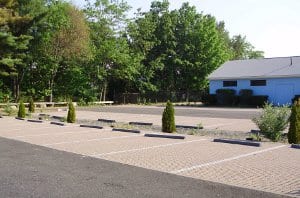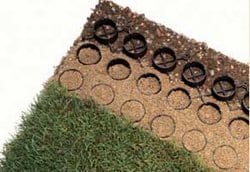by Steven Roy
The use of porous surfaces for stormwater management and control has become a widely accepted practice. This brief article will explore why porous surfaces are important as one of our management tools and report on a few new and interesting products within the porous surface toolbox.
Our urban and suburban areas have been effectively built and plumbed to take all of our impervious surfaces (roads, parking areas, rooftops, etc.) and quickly collect and discharge our stormwater to the nearest lake, pond, stream or wetland. Road designs, subdivision regulations, site plan requirements have all had the goal of removing stormwater runoff from precipitation and melting snow in the most effective and quickest manner possible.
As I am writing this piece, the news is filled with the flooding of Peabody, MA and Swampscott, MA from a heavy rainfall event on October 4, 2011. Between 4 to 6 inches of rain fell in these Massachusetts North Shore communities resulting in major flooding, the closing of roads, and the inundation of homes and businesses. Our solution in the past has always been to make the pipes bigger and push the problem downstream to our unfortunate neighbors that live at the bottom of the watershed. Flooding of urban areas has been the consequence of this type of planning.
Focus on “Retain onsite”
Throughout the U.S., the focus on stormwater management is now changing to control stormwater as much as possible at the site level. “Retain onsite” is the current tactic that federal, state and local regulators are employing to manage stormwater. For example, the USEPA Region 1 has proposed a Draft Municipal Stormwater Permit for Massachusetts that states, “Stormwater controls are designed such that there is no discharge of stormwater from the volume associated with a 1 inch storm event.” The permit further states that “the permittee is encouraged to require the capture of at least the 1 inch (90th percentile) storm event. The term ‘capture’ includes practices that infiltrate, evapotranspire, and/or harvest and reuse rainwater. This means that 100 percent of the volume of water from events less than or equal to the 90th percentile event shall not be discharged. In Massachusetts, the 90th percentile is a 1 inch storm event.”
In order to retain stormwater onsite, there is a need to create opportunities for stormwater to infiltrate and recharge groundwater and provide baseflow to our streams and wetlands. Porous surfaces and associated products allow development and land use to proceed while providing a window of opportunity for stormwater to infiltrate beneath the surface.
Porous surfaces for new development and redevelopment or retrofits come in a wide variety of products and approaches and many have moved into the mainstream as accepted practices. The following products are in widespread use in New England as porous surfaces for stormwater control. Internet links for more information on each product are included.
Porous Asphalt/Porous Concrete
Porous asphalt and porous concrete have been around for many years and have been used as effective stormwater control measures. More recently, asphalt batch mixes have improved and the capabilities of installers to effectively lay porous concrete and asphalt have also improved. Manufacturers have become more comfortable with porous products and installers have become better trained. The National Asphalt Pavement Association has produced standardized technical guidance on the design, construction and maintenance of porous asphalt pavements. The National Ready Mixed Concrete Association has similar materials and training for the installation of porous concrete. In addition, and most applicable to New England, the University of New Hampshire Stormwater Center, UNHSC has published specifications for the proper batching and installation of porous asphalt. These specifications have become the best standard in New England for this product.
Sand and salt usage and maintenance of porous surfaces is a concern for many municipalities. The reality with this practice is that if you are careful and actually conduct vacuuming twice per year you can maintain the infiltration rate on the surface that you started with for many years. With regard to sanding, it should be avoided on porous surfaces. The sand will clog the void spaces and reduce the overall infiltration rate over time. The UNHSC has reported that based on their research over several years, that salt application can be reduced by 75% and the porous asphalt can still meet two important winter measures: friction and snow and ice cover. The porous surfaces actually speed snow and ice melt. UNHSC has prepared a very handy summary of the winter maintenance requirements of porous pavements. This finding could be very important to water suppliers and municipalities that are attempting to reduce the impact of winter deicing on public water supplies while managing stormwater to meet new infiltration requirements.
One new twist in the porous concrete market is a new modular porous concrete paver called StormCrete™ . This product is a porous concrete panel (4’ x 7’) that is precast under controlled conditions and delivered to the site as panels that are placed over a compacted stone bed. This product eliminates the problem of the high-cost, labor intensive installation of poured-in-place porous asphalt and the additional problems of proper curing conditions. An additional benefit is that if the surface clogs with sediment or debris, the panel can be easily removed, replaced, or cleaned.
Permeable Interlocking Concrete Pavers
Permeable pavers are included in almost all of the state stormwater manuals as a technique to promote stormwater infiltration and to reduce the amount of stormwater volume that must be treated. Permeable pavers can reduce the peak flow by as much as 100%, bringing runoff volumes nearer to pre-development levels. As described on the Interlocking Concrete Pavement Institute (ICPI) website, “Permeable interlocking concrete pavement (PICP) is comprised of a layer of concrete pavers separated by joints filled with small stones. Water enters the joints between solid concrete pavers and flows through an “open-graded” base, i.e. crushed stone layers with no small or fine particles. The void spaces among the crushed stones store water and infiltrate it back into the soil subgrade. The stones in the joints provide 100% surface permeability, and the base filters stormwater and reduces pollutants.” ICPI is a manufacturer supported testing, training, and design organization that provides technical guidance and materials for the proper use of PICP. ICPI has produced several free fact sheets on permeable pavers for different target audiences including universities, municipal officials, developers, and design professionals. The fact sheets were developed in conjunction with the Low Impact Development Center, a non-profit group dedicated to information exchange on sustainable development.
One of the newer aspects from ICPI is information and guidance on how PICP can help developers obtain green design credits within the Leadership in Energy and Environmental Design (LEED®) program of the US Green Building Council. Not only can PICP installation help a builder obtain credits for stormwater quality and quantity control, but if lighter-colored products are used then credits can be obtain for reducing the heat-island effect from the building and surrounding grounds. In addition if the materials are supplied locally (the pavers and the stone base) points can be obtained for locally-sourced materials. Up to 27 points of the 40 points required to reach LEED® Certified for a building can be obtained using PICP according to the ICPI.
Research on the effectiveness of PICP for stormwater control is underway at the University of New Hampshire Stormwater Center. In addition to research of the effectiveness of porous asphalt, PICP demonstration sites have been installed to document how PICP works in a New England climate. A video shows the installation of PICP at the University of NH.
Other Porous Surfaces and New and Interesting Products
There are many other manufactured products available in the form of porous surfaces. One product called KBI Flexi®-Pave has received excellent reviews. This product is manufactured in-place by combining aggregate (stones), recycled tire products, and a polyurethane binder that holds the product together.
This approach works well for walkway, tree surrounds, parking spaces, and play surfaces. The infiltration rate for KBI Flexi®-Pave is exceptionally high resulting in complete capture of all rainfall events and 100% infiltration when placed on an appropriate stone bed. Similar to PICP, KBI Flexi®-Pave and be produced in a range of colors including lighter colors to reduce heat-island effect. KBI Flexi®-Pave is an interesting concept because the application of used tires is helping to solve a problem with the disposal of tires into our environment.
A company called Invisible Structures produces several products based on the concept of plastic cups filled with stone or soil. Gravelpave2 consists of rolls of plastic cups adhered to a permeable textile and back-filled with small stone. It is placed on a compacted bed of uniformly-graded crushed stone and can be driven on immediately. This product has exceptional infiltration capacities and works best for overflow parking areas, storage yards, and other areas with limited traffic flow. Snowplowing is a limitation of this product.
A sister product to Gravelpave2 is Grasspave2. The concept is the same except the manufacture provides a concrete sand to fill the cups and you have the option of laying sod or hydroseeding. The result is a surface that looks like a grassed lawn but it provides the structural support for parking vehicles. The infiltration rate is very high but this product does require maintenance to maintain the grass.
Finally, Gravel-Lock Porous Stone Paving is a new product that involves pouring a liquid binding material over an existing stone bed. The viscosity of the liquid coats the stones from the top down creating a bonded stone surface. The product can bond stone from ¼” up to 3” in diameter. The result is a porous surface that is suitable for walking paths and tree pits.
The products available to create porous surfaces while allowing uses on the surface are many. Manufacturers are creating new and better products daily. As stormwater regulations continue to push for more onsite control and infiltration, the use of porous products will increase. The caution with all of these products is to make sure that they are designed, installed, and maintained properly to ensure that they are performing as intended.
About the Author
Steven Roy is a water resources planner and scientist with Geosyntec Consultants, Inc., Acton, MA. He has over 30 years of professional experience in the field of environmental program management specializing in water resources assessment, stormwater management, and environmental impact assessment. His work focuses on the assessment of water resource impacts from land use activities. Steve has managed several stormwater projects that have included conceptual and engineered designs for innovative stormwater best management practices. Many of these designs have included constructed wetlands, bioretention cells, water quality swales, raingardens, porous pavement, planter boxes, and other water quality controls. Steve is a LEED Accredited Professional with the USGBC and may be reached at Sroy@Geosyntec.com.







